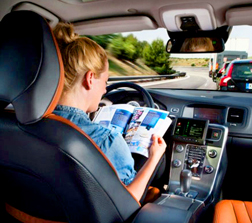Self-driving Cars Will Be Safer, But Surprises Will Happen
 Self-driving cars are promising to make our roadways much safer, but there will be unintended consequences that will need a consistent national legal and regulatory framework, according to experts who spoke at the opening of a major engineering conference in late-April.
Self-driving cars are promising to make our roadways much safer, but there will be unintended consequences that will need a consistent national legal and regulatory framework, according to experts who spoke at the opening of a major engineering conference in late-April.
A panel moderated by Richard Wallace from the Center for Automotive Research opened the SAE World Congress with a wide-ranging discussion of the current status and likely future of automated transportation.
Currently, about 1.2 million people die each year in traffic accidents worldwide and more than 90 percent are caused by driver error, said Steffen Linkenbach, Continental's North American Director of Systems and Technology. The software and algorithms already being created to guide early self-driving prototypes will sharply reduce, if not eliminate those mistakes.
"Am I concerned that something could go wrong with an automated car? Yes. But I'm terrified by what happens with all these human drivers," said Bryant Walker Smith, Professor of Law and Engineering at the University of South Carolina.
Pat Bassett, Denso's Vice President for North American Research and Engineering, outlined the five levels of automated driving, the first two of which cover features such as anti-lock brakes, adaptive cruise control, or lane-departure assist that are becoming common in human-driving vehicles. Bassett said Denso's market-ready technology is now at Level 2.
Levels 3 through 5 cover increasingly sophisticated features, ranging from requiring driver intervention in a few scenarios to Level 5 where there's no steering wheel.
"We believe this period (from Level 2 to Level 5) will be quite lengthy," Bassett said.
Toshio Yokoyama, Senior Chief Engineer for Honda R&D Center in Ohio, showed a slide that quantified lost productivity from traffic deaths and injuries, based on 2013 data, at $78 billion annually in the U.S. and $75 billion in Japan. If self-driving cars can reduce that significantly the economic case for them will be hard to resist.
But the way automakers sell the new technology and the customers they sell them to could change drastically. "Manufacturers' business models for Level 4 automation won't look the same as the business models that drive them today," Walker Smith said. For example, there could be fleets of robo-taxis ferrying people from point to point in a densely populated city.
"It could be a world where people are buying trips and miles and experiences and not cars," said Larry Burns, a former GM Vice President of Research and Development. "Other people are owning the cars to provide the service." Would they eventually lead to s drop in new car sales? "We'll need a lot of cars to move the miles people want to travel," Burns said. "The car will be used up much faster. A shared car would have 80,000 miles a year versus your car that may have 12,000."
Walker Smith cautioned that regulations and laws could delay implementation of self-driving cars and there will be unforeseen problems. "Things will go wrong. So manufacturers should have a break-the-glass plan ready when their first automated vehicle is in an accident," he said. "Given that the status quo of distracted behavior, or even the failure to fasten seatbelts, is unacceptable, the change is coming."
 Self-driving cars are promising to make our roadways much safer, but there will be unintended consequences that will need a consistent national legal and regulatory framework, according to experts who spoke at the opening of a major engineering conference in late-April.
Self-driving cars are promising to make our roadways much safer, but there will be unintended consequences that will need a consistent national legal and regulatory framework, according to experts who spoke at the opening of a major engineering conference in late-April.